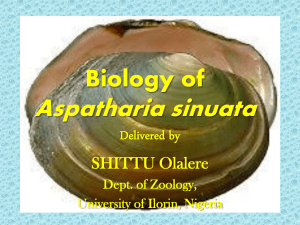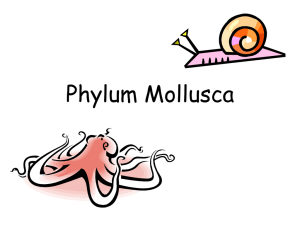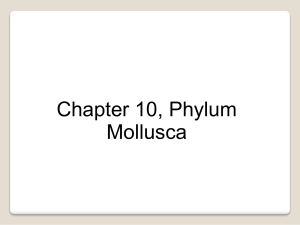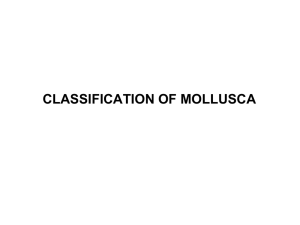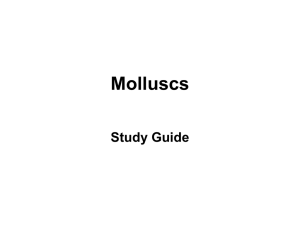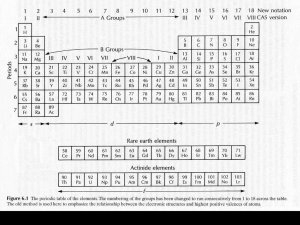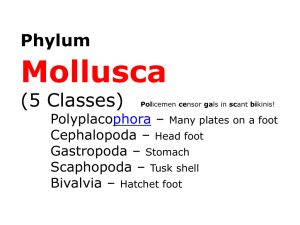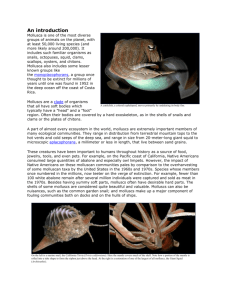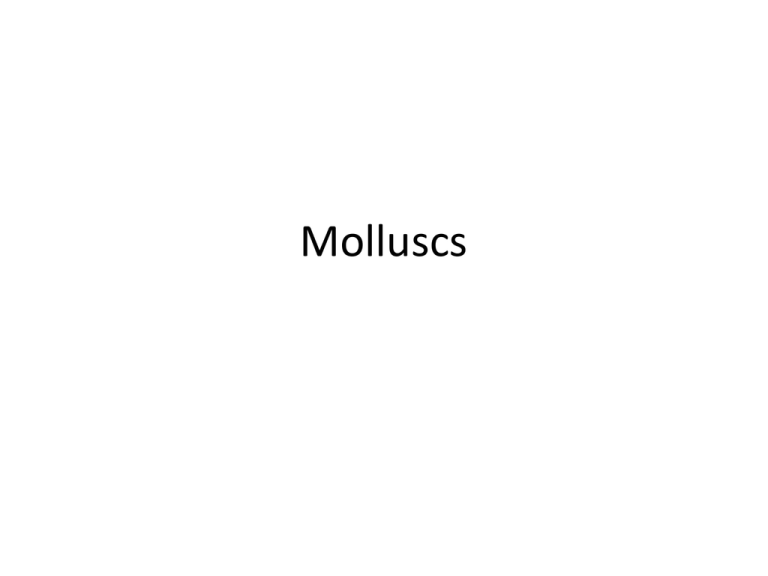
Molluscs
Development of the coelom
• In the precambrian era, the most complex
animals in the seas were acoelomate
• With time, some animals developed a more
elaborate anatomy, a space called a coelom
– It is lined with mesoderm, and organs within it are
suspended by mesenteries
– The coelom is an efficient hydrostatic skeleton, with
circular and longitudinal muscles acting against each
other
• Development of the coelom was a major step in
the evolution of the larger and more complicated
phyla, beginning with the molluscs
Characteristics of the Phylum Mollusca
• A very large phylum with 90,000 living species
and 70,000 extinct fossil species
– Many more molluscs have not been formally
named yet
• While many have a shell, the body is soft
• This phylum includes chitons, tooth shells,
snails, slugs, nudibranchs, sea butterflies,
clams, mussels, oysters, squid, octopuses and
nautiluses
Representative Molluscs
Mollusc Characteristics
• Some molluscs such as Tridactna (the giant clam)
may weight (counting the shell) as much as 900
pounds.
• Squid may be over 50 feet long; many molluscs,
however are about 2 inches
• Shell collecting has been a popular hobby for
many people for hundreds of years
– Native Americans in the Gulf of Mexico region used
seashells as money in trade with neighboring tribes
Classes of Molluscs
•
•
•
•
•
•
•
•
Gastropoda - snails with shells and slugs
Bivalvia - clams, oysters
Polyplacophora – chitins
Cephalopoda – squid, nautiluses, octopuses
Monoplacophora
Scaphopoda
Caudofoveata
Solenogastres
Relationships among Molluscs
Ecological Relationships
• Molluscs are found from the tropics to the polar seas
• Most live in the sea as bottom feeders, burrowers,
borers, grazers, carnivores, predators and filter feeders
• Fossil evidence indicates that molluscs evolved in the
sea and most have remained marine
• Some bivalves and gastropods have moved to estuaries
(brackish) and freshwater
• Only snails have been successful living on land, they
are most common where the habitat is moist and
sheltered, with calcium available in the soil for their
shells
Economic Importance
• Oysters “on the half-shell” are a way of life in Florida
(and other states as well)
• Digging clams at low tide in coastal states provides
much needed income
• Culturing of oysters for pearls is probably a billion
dollar industry; in Japan in the 1960’s, you could pay $1
for an oyster and were guaranteed a pearl
• - There are freshwater pearls too!!
• Teredo, the burrowing worm (but really a mollusc),
causes untold damage to wooden docks, as well as
wooden boats
• Snails and slugs are unwelcome guests in the garden
Mollusc Body Plan
• The head-foot portion contains the feeding,
sensory, and locomotor organs
• The visceral mass portion contains digestive,
circulatory, respiratory, and reproductive organs
• The protective mantle is formed by two folds of
skin
• The space between the mantle and body wall is
the mantle cavity
• Within the mantle cavity are the gills (or lungs, in
the case of pulmonate snails)
• In most molluscs, the mantle secretes a
protective shell over the visceral mass
Anatomy of a generalized Mollusc
The head-foot complex
• Most molluscs have a well-developed head
bearing the mouth and some sensory organs
• Photosensory receptors range from simple
eyes to complex eyes such as in the squid
• Tentacles may be present
• Posterior to the mouth is the chief locomotor
organ, the foot
The Radula (Fig. 10.4)
• The radula is found only in the molluscs; it is found in
all except bivalves, some gastropods and solenogasters
• It is a protruding, rasping (like a wood file), tongue-like
organ
• On the radula are rows of tiny teeth, up to 250,000,
pointed backward
• By a filing action, the radula rasps off fine particles of
food material from surfaces, but can also drill a hole
through hard shells
• The radula moves the particles of food to the digestive
tract
• Movements of the radula are supported by complex
muscles and cartilages (called the odontophore)
The molluscan foot
• The foot is usually ventrally located
• It can be used to attach to the bottom of the
ocean or lake (called the substratum) or can also
be used in location (clam vs squid or the tortoise
and the hare)
• Modifications of the foot include the attachment
disc of limpets, and the siphon jet of squid)
• The foot often secretes mucus which aids in
adhesion or in helping some molluscs glide on
cilia
The Visceral Mass
Mantle and Mantle Cavity
• A mantle is a sheath of skin on each side of the body, it
secretes the shell when present
• The mantle cavity contains the gills or lungs that develop
from the mantle
• The exposed surface of the mantle also serves for gaseous
exchange
• Digestive, excretory, and reproductive products are
emptied into the mantle cavity
• In aquatic molluscs, a continuous flow of water brings in
oxygen and food, and flushes out wastes
• Cephalopods (squid) use the head and mantle cavity to
create jet propulsion
The Shell
• When present, the shell is secreted by the mantle and
is lined by it
• The outer layer of the mantle is called the
periostracum, and is composed of conchiolin (a tough
membrane made of protein)
• The middle of the shell is the prismatic layer made of
calcium carbonate
• The periostracum protects the shells of freshwater
molluscs from acid caused by decaying leaves
• The shell appears during the larval period and grows
throughout life
The shell and mantle of a bivlave
Internal Structure and Function
• The open circulatory system includes a
pumping heart, blood vessels and blood
sinuses
– The open circulatory system is the most common
type in molluscs
• Most cephalopods have a closed system with a
heart, vessels, and capillaries
• The digestive system is quite complicated and
specialized for different feeding habits
Internal Structure and Function
• Most molluscs have a pair of kidneys called
metanephridia
• The kidney ducts also discharge sperm and eggs
• The nervous system has pairs of ganglia with
various specialized sense organs
• Most molluscs are dioecious (separate sexes) but
some gastropods are hermaphroditic
• The egg hatches into a free-swimming
trochophore larvae
• In many gastropods and bivalves, there is an
intermediate stage, the veliger, wich occurs next
Trochophore Larva
Class Monoplacophora
• Thought to be extinct, a living specimen was
found in 1952; a dozen species are now known
• Small molluscs with rounded shells resembling
limpets
• Some indication of segmentation (or
metamerism) suggesting the ancestor was also
segmented
• Neopilina, however, only shows
pseudometamerism
Class Monoplacophora
Class Polyplacophora (chitons)
• Flattened mollscs about 2 inches long, with 8
overlapping dorsal plates
• Most prefer rocky intertidal surfaces, and survive by
scraping algae from the rocks with their radula
• The mantle extends around the chiton margin, forming
a girdle
• Gills are suspended from the roof of the mantle cavity
and grooves form a closed chamber so water flows
from anterior to posterior
• The plates have photosensitive structures to perceive
light
• Osphradia serve as a sense organ to sample water in
the mantle cavity
• Sexes are separate; a trochopore larva is present
Anatomy of a Chiton
Scaphopoda (the tooth shells)
• Live in the marine environment
• Slender body covered with a mantle; the shell is open
at both ends
• Foot protrudes from the larger end to burrown into md
• The foot and ciliary action move respiratory water
through the mantle cavity
• Gills are absent and gaseous exchange occur via the
mantle
• Detritus and protozoa are caught on cilia on the foot or
the mucous-covered knobs of the tentacles
Dentalium, a scaphopods
Class Gastropoda
• The most diverse of the molluscs; contains
70,000 living and 15,000 extinct species
• Includes snails, slugs, limpets, whelks,conches,
periwinkles, sea slugs, sea hares, sea
butterflies
• From marine forms with ancestral features to
air-breathing terrestrial snails and slugs
• Gastropod shells are one-piece univalves,
coiled or uncoiled
Torsion in the gastropods
• All living gastropods have descended from ancestors
which were both coiled and torted, whether they show
those features today or not
• Torsion is a twisting process that begins with the
veliger larva, changing it from a bilateral to an
asymmetrical form
• The mantle cavity moves from the rear position (shown
in the picture of the ancestral mollusc) and comes to
rest over the head, facing towards incoming water
• When torsion is completed, the gills, anus, and
reproductive glands
Torsion in the gastropods
• It is not known what the original advantages were
to ancestral gastropods in adopting torsion
• It may have some advantages and disadvantages
– An advantage may be that the gills face fresh incoming
water with high oxygen content
– The disadvantage is the waste products from the anus
come out just above the head where sensory organs
are located
– However, the mantle cavity is designed in such a way
that wastes are quickly dispersed into the water
– Also, the sperm and eggs are also sent out into the
water in the same way
Torsion and coiling in the gastropods
Feeding habits of gastropods
• Having a radula results in much variation in how
snails feed
• Many are herbivorous; some graze on plankton
• Some scavenge on decaying flesh, others are
active carnivores using the radula to ear apart
prey
• Oyster drills and moon snails drill holes in the
shells of bivalves and insert their proboscis to
such out tissues and juice
• Species of Conus can deliver a lethal stink to
capture prey
Other gastropod structures
• Land snails that are pulmonates have a highly
vascular area in the mantle that acts as a lung
• Aquatic pulmonates come to the surface to
expel a gas bubble and then inhale by forming
a siphon with their mantle
• The sense organs of gastropods include eyes,
statocysts, tactile organs and chemoreceptors
• Gastropods include both monecious and
dioecious species
Class bivalvia
• This class includes mussels, clams, scallops,
oysters and shipworms (Teredo)
• They range from 1 mm to hundreds of pounds
• Most are sedentary suspension feeders
dependent on ciliary currents to bring in small
particles of food
• They lack a head, radula, or any other kind of
cephalization
• Most are marine; some live in freshwater
streams, ponds and lakes
Shell morphology
• The two shells or valves are held together by a very strong
hinge ligament
• The valves are drawn together by strong adductor muscles
• The umbo is the bulge, and is the oldest part of the shell with
growth occurring outward in rings
Body and Mantle
• A visceral mass is suspended from the dorsal
midline, with gills hanging down on each side
• The foot is attached anteroventrally
• The posterior edges of the mantle form
excurrent and incurrent openings
– These “siphons” can be very long in clams that
burrow in sand or mud
• Bivalves have a three-chambered heart that
pumps blood to the gills, mantle, and kidney
Feeding mechanism of freshwater clams
Anatomy of a freshwater clam
Feeding and digestion
• Suspended organic matter enter the incurrent siphon
• Gland cells on the gills secrete mucous which entangles
the food particles
• The food particles then slide to food grooves at the
bottom of the gill
• Cilia and grooves on the labial palps direct the mucous
mass into the mouth
• In the stomach, the mucus and food particles are kept
mixed by the crystalline style which produces enzymes
• The stomach sorts food particles and directs them to
the digestive gland for intracellular digestion
Locomotion in the bivalves
• The slender foot is extended out between the
valves
• Blood is pumped into the foot; it swells and
anchors the bivalve in the mud
• Shortening the foot then pulls the clam forward
• Locomotion in scallops is accomplished by
clapping their valves to create a jet propulsion
effect, the mantle guides the stream of water
• Some mussels don’t move once they complete
the larval stage; mussels attach by byssal threads
Reproduction and development
• Sexes are usually separate, oysters undergo
protandry where they start out as males and then
change sex and become females
• Fertilization of eggs by sperm is external
• Embryos develop as trochophore larva, some
then develop into veligers, and end up as spat
larval stages before settling down to the bottom
and metamorphosing into adults
• The larvae of freshwater clams develop into
glochidia which attach to the gills of fish where
they live for a short time as parasites
The glochidia of freshwater clams
• The glochidia eventually leave the gills of the fish and settle to
the bottom; this hitchhiking helps to increase the distribution
of the species
• Freshwater clams are highly sensitive to pollution and thus
their survival is in question
Class Cephalopoda
• This class includes squids, octopuses,
nautiluses, devilfish and cuttlefish
• All are marine predators
• The giant squid is the largest invertebrate
known
• The eye of the giant squid (Architeuthis”) is 10
inches in diameter and very sophisticated in
structure
Class Cephalopoda
• Cephalopods feed on fish, mollusks,
crustaceans, and worms
• The foot is in the head region and is modified
for expelling water from the mantle cavity
• Octopuses and cuttlefish secrete venom from
the salivary glands
• The beaklike jaws grasp prey; the radula tears
off pieces of flesh
The shell of the cephalopod
• The shell of the cuttlefish and squid are enclosed
internally within the mantle cavity
• The octopus has completely loss the shell
• The Nautilus in ancient times, had a shell which
was straight but overtime, has become coiled
– The shell of the Nautilus fills with gas which causes it
to stay upright; they can swim
– Because the Nautilus may be found swimming as deep
as 400 meters, the atmospheric pressure on the shell
may be as high as 600 pounds per square inch
The chamber Nautilus
Body and Mantle of the Cephalopod
• Octopods have 8 arms with suckers; squid
have 10 arms, 8 arms with suckers and pair of
long retractile tentacles
• Tentacles grasp food causing it to adhere with
secretions, not suckers
Body and Mantle of the Cephalopod
• Water enters the mantle cavity through the neck
region
– Contraction of the mantle edges about the neck
expels water through the funnel
– Water currents provide oxygen to the gills, they also
create water propulsion, and carry waste and
reproductive products away from the body
• The cephalopod brain is the largest of an
invertebrate
• Sense organs are well developed, the eyes are
complex, complete with cornea, lens and retina
The eye of the cuttlefish
Special features of cephalopods
• Cephalopods can change color by expanding
and contracting chromatophores in the skin
• This process is controlled by the nervous
system
• Many of the color changes are associated with
alarm signals or mating
• Some deep-sea squids are bioluminescent
• Many cephalopods can eject ink which forms a
smokescreen that may confuse an enemy
when released
Reproduction
• Sexes are separate
• Males display and court females
• Fertilization is internal and are attached to
stones or other objects to develop
• Some of the octopii provide parental care to
their eggs until they hatch


